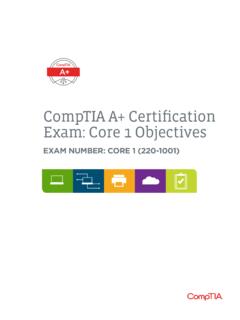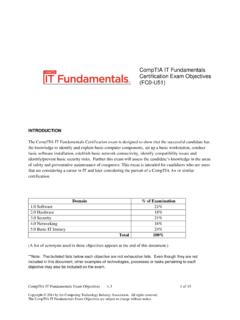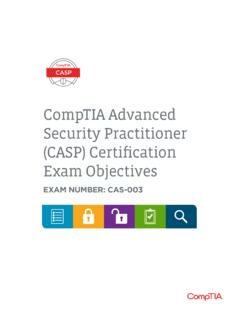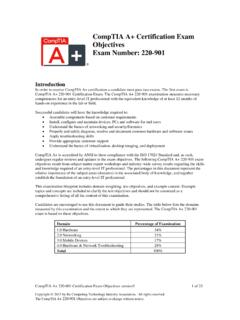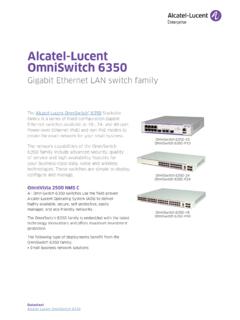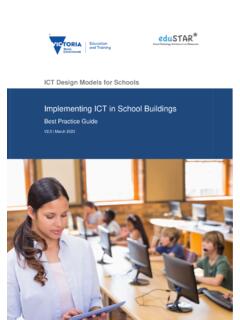Transcription of CompTIA Network+ Certification Exam Objectives
1 CompTIA network + Certification Exam ObjectivesEXAM NUMBER: N10-007 The CompTIA network + Certification is an internationally recognized validation of the technical knowledge required of foundation-level IT network Purpose: This exam will certify the successful candidate has the knowledge and skills required to troubleshoot, configure, and manage common network devices; establish basic network connectivity; understand and maintain network documentation; identify network limitations and weaknesses; and implement network security, standards, and protocols. The candidate will have a basic understanding of enterprise technologies, including cloud and virtualization network + is accredited by ANSI to show compliance with the ISO 17024 Standard and, as such, the exam Objectives undergo regular reviews and network + candidates are recommended to have the following.
2 CompTIA A+ Certification or equivalent knowledge At least 9 to 12 months of work experience in IT networkingEXAM ACCREDITATIONThe CompTIA network + exam is accredited by the American National Standards Institute (ANSI) to show compliance with the International Organization for Standardization (ISO) 17024 Standard and, as such, undergoes regular reviews and updates to the exam DEVELOPMENTCompTIA exams result from subject matter expert workshops and industry-wide survey results regarding the skills and knowledge required of an entry-level IT AUTHORIZED MATERIALS USE POLICY CompTIA Certifications, LLC is not affiliated with and does not authorize, endorse or condone utilizing any content provided by unauthorized third-party training sites (aka brain dumps ). Individuals who utilize such materials in preparation for any CompTIA examination will have their certifications revoked and be suspended from future testing in accordance with the CompTIA Candidate Agreement.
3 In an effort to more clearly communicate CompTIA s exam policies on use of unauthorized study materials, CompTIA directs all Certification candidates to the CompTIA Certification Exam Policies. Please review all CompTIA policies before beginning the study process for any CompTIA exam. Candidates will be required to abide by the CompTIA Candidate Agreement. If a candidate has a question as to whether study materials are considered unauthorized (aka brain dumps ), he/she should contact CompTIA at to confirm. PLEASE NOTEThe lists of examples provided in bulleted format are not exhaustive lists. Other examples of technologies, processes or tasks pertaining to each objective may also be included on the exam although not listed or covered in this Objectives document. CompTIA is constantly reviewing the content of our exams and updating test questions to be sure our exams are current and the security of the questions is protected.
4 When necessary, we will publish updated exams based on existing exam Objectives . Please know that all related exam preparation materials will still be valid. About the ExamCompTIA network + Certification Exam Objectives Version (Exam Number: N10-007)TEST DETAILSR equired exam CompTIA network + N10-007 Number of questions Maximum of 90 Types of questions Multiple choice and performance-basedLength of test 90 minutesRecommended experience CompTIA A+ Certified, or equivalent Minimum of 9 months of experience in network support or administration; or academic trainingPassing score 720 (on a scale of 100 900)EXAM Objectives (DOMAINS)The table below lists the domains measured by this examination and the extent to which they are represented: CompTIA network + Certification Exam Objectives Version (Exam Number.)
5 N10-007)DOMAIN PERCENTAGE OF Networking Concepts 23% Infrastructure 18% network Operations 17% network Security 20% network Troubleshooting and Tools 22%Total 100% Protocols and ports - SSH 22 - DNS 53 - SMTP 25 - SFTP 22 - FTP 20, 21 - TFTP 69 - TELNET 23 - DHCP 67, 68 - HTTP 80 - HTTPS 443 - SNMP 161 - RDP 3389 - NTP 123 - SIP 5060, 5061 - SMB 445 - POP 110 - IMAP 143 - LDAP 389 - LDAPS 636 - 1720 Protocol types - ICMP - UDP - TCP - IP Connection-oriented vs. connectionless Layer 1 Physical Layer 2 Data link Layer 3 network Layer 4 Transport Layer 5 Session Layer 6 Presentation Layer 7 Application Properties of network traffic - Broadcast domains - CSMA/CD - CSMA/CA - Collision domains - Protocol data units - MTU - Broadcast - Multicast - Unicast Segmentation and interface properties - VLANs - Trunking ( ) - Tagging and untagging ports - Port mirroring - Switching loops/spanning tree - PoE and PoE+ ( , ) - DMZ - MAC address table - ARP table Routing - Routing protocols (IPv4 and IPv6)
6 - Distance-vector routing protocols - RIP - EIGRP - Link-state routing protocols - OSPF - Hybrid - BGP - Routing types - Static - Dynamic - Default IPv6 concepts - Addressing - Tunneling - Dual stack - Router advertisement - Neighbor discovery Performance concepts - Traffic shaping - QoS - Diffserv - CoS NAT/PAT Port forwarding Access control list Distributed switching Packet-switched vs. circuit- switched network Software-defined Networking ConceptsExplain the purposes and uses of ports and devices, applications, protocols and services at their appropriate OSI the concepts and characteristics of routing and network + Certification Exam Objectives Version (Exam Number: N10-007) Private vs.
7 Public Loopback and reserved Default gateway Virtual IP Subnet mask Subnetting - Classful - Classes A, B, C, D, and E - Classless - VLSM - CIDR notation (IPv4 vs. IPv6) Address assignments - DHCP - DHCPv6 - Static - APIPA - EUI64 - IP reservations Wired topologies - Logical vs. physical - Star - Ring - Mesh - Bus Wireless topologies - Mesh - Ad hoc - Infrastructure Types - LAN - WLAN - MAN - WAN - CAN - SAN - PAN Technologies that facilitate the Internet of Things (IoT) - Z-Wave - Ant+ - Bluetooth - NFC - IR - RFID - standards - a - b - g - n - ac Cellular - GSM - TDMA - CDMA Frequencies - - Speed and distance requirements Channel bandwidth Channel bonding MIMO/MU-MIMO Unidirectional/omnidirectional Site surveysGiven a scenario, configure the appropriate IP addressing and contrast the characteristics of network topologies, types and a scenario, implement the appropriate wireless technologies and Networking ConceptsCompTIA network + Certification Exam Objectives Version (Exam Number.)
8 N10-007)Summarize cloud concepts and their the functions of network Types of services - SaaS - PaaS - IaaS Cloud delivery models - Private - Public - Hybrid Connectivity methods Security implications/considerations Relationship between local and cloud resources DNS service - Record types - A, AAAA - TXT (SPF, DKIM) - SRV - MX - CNAME - NS - PTR - Internal vs. external DNS - Third-party/cloud-hosted DNS - Hierarchy - Forward vs. reverse zone DHCP service - MAC reservations - Pools - IP exclusions - Scope options - Lease time - TTL - DHCP relay/IP helper NTP Networking ConceptsCompTIA network + Certification Exam Objectives Version (Exam Number: N10-007) Media types - Copper - UTP - STP - Coaxial - Fiber - Single-mode - Multimode Plenum vs.
9 PVC Connector types - Copper - RJ-45 - RJ-11 - BNC - DB-9 - DB-25 - F-type - Fiber - LC - ST - SC - APC - UPC - MTRJ Transceivers - SFP - GBIC - SFP+ - QSFP - Characteristics of fiber transceivers - Bidirectional - Duplex Termination points - 66 block - 110 block - Patch panel - Fiber distribution panel Copper cable standards - Cat 3 - Cat 5 - Cat 5e - Cat 6 - Cat 6a - Cat 7 - RG-6 - RG-59 Copper termination standards - TIA/EIA 568a - TIA/EIA 568b - Crossover - Straight-through Ethernet deployment standards - 100 BaseT - 1000 BaseT - 1000 BaseLX - 1000 BaseSX - 10 GBaseT Firewall Router Switch Hub Bridge Modems Wireless access point Media converter Wireless range extender VoIP InfrastructureGiven a scenario, deploy the appropriate cabling a scenario, determine the appropriate placement of networking devices on a network and install/configure network + Certification Exam Objectives Version (Exam Number.)
10 N10-007) InfrastructureExplain the purposes and use cases for advanced networking the purposes of virtualization and network storage and contrast WAN Multilayer switch Wireless controller Load balancer IDS/IPS Proxy server VPN concentrator AAA/RADIUS server UTM appliance NGFW/Layer 7 firewall VoIP PBX VoIP gateway Content filter Virtual networking components - Virtual switch - Virtual firewall - Virtual NIC - Virtual router - Hypervisor network storage types - NAS - SAN Connection type - FCoE - Fibre Channel - iSCSI - InfiniBand Jumbo frame Service type - ISDN - T1/T3 - E1/E3 - OC-3 OC-192 - DSL - Metropolitan Ethernet - Cable broadband - Dial-up - PRI Transmission mediums - Satellite - Copper - Fiber - Wireless Characteristics of service - MPLS - ATM.
